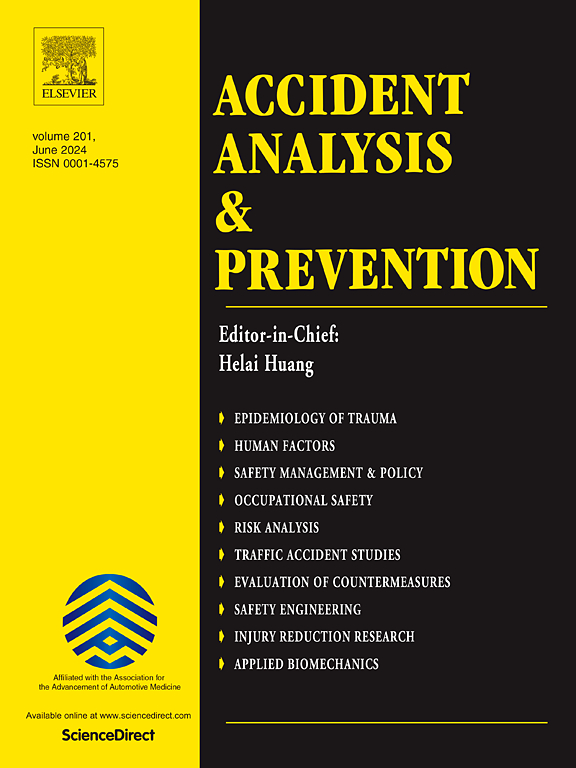Dynamic short-term crash risk prediction from traffic conflicts at signalized intersections with emerging mixed traffic flow: A novel conflict indicator
IF 6.2
1区 工程技术
Q1 ERGONOMICS
引用次数: 0
Abstract
Dynamic short-term crash risk prediction derived from traffic conflicts can provide significant support for proactive safety management at signalized intersections. Especially after the formation of emerging mixed traffic flow, an accurate prediction of future crash risk can help conceive proactive crash prevention measures. However, the precision of crash risk estimation at signalized intersections with emerging mixed traffic flow is still subject to doubt, largely attributable to the lack of an exclusive conflict indicator. This situation presents considerable challenges to the dynamic short-term crash risk prediction at signalized intersections with emerging mixed traffic flow. Therefore, this study performs dynamic short-term crash risk prediction from traffic conflicts at signalized intersections with emerging mixed traffic flow by combining the non-stationary generalized extreme value (GEV) model and the self-attention mechanism-based online learning long short-term memory (SAM-OL-LSTM) approach. A novel conflict indicator, the time to avoid a crash (TTAC), is developed to describe traffic conflicts in the emerging mixed traffic flow. Based on TTAC, a non-stationary GEV model that considers acceleration variance as a covariate is developed to calculate the value at risk (VaR) for each minute, which is used to dynamically quantify crash risk at signalized intersections. Afterwards, the SAM-OL-LSTM approach that considers traffic volume and the uncertainty in vehicle speed distribution as two input features is proposed to dynamically predict the VaR for the future one minute based on the VaR time series data of the prior five minutes. The results indicate that: i) the proposed SAM-OL-LSTM approach outperforms baseline approaches under various MPRs in terms of prediction accuracy; ii) the application of VaR facilitates a dynamic quantification of the crash risk at an intra-minute temporal resolution; iii) the developed TTAC exhibits a strong capability in identifying traffic conflicts in the emerging mixed traffic flow at signalized intersections. The findings of this study can provide a theoretical foundation for proactive traffic control considering the future crash risk in the emerging mixed traffic flow at signalized intersections.
基于混合交通流的信号交叉口交通冲突动态短期碰撞风险预测:一种新的冲突指标
基于交通冲突的动态短期碰撞风险预测可以为信号交叉口的主动安全管理提供重要支持。特别是在新兴混合交通流形成后,对未来碰撞风险的准确预测有助于构思主动的碰撞预防措施。然而,混合交通流信号交叉口碰撞风险估计的精度仍然存在疑问,这主要是由于缺乏排他的冲突指标。这种情况对新出现的混合交通流信号交叉口动态短期碰撞风险预测提出了相当大的挑战。因此,本研究结合非平稳广义极值(GEV)模型和基于自注意机制的在线学习长短期记忆(SAM-OL-LSTM)方法,对新兴混合交通流下的信号交叉口交通冲突进行动态短期碰撞风险预测。为了描述新兴混合交通流中的交通冲突,提出了一种新的冲突指标——避免碰撞时间(TTAC)。基于TTAC,建立了以加速度方差为协变量的非平稳GEV模型,计算每分钟的风险值(VaR),用于动态量化信号交叉口的碰撞风险。然后,提出了以交通量和车速分布不确定性为两个输入特征的SAM-OL-LSTM方法,基于前5分钟的VaR时间序列数据动态预测未来1分钟的VaR。结果表明:1)在不同mpr下,SAM-OL-LSTM方法的预测精度优于基线方法;ii) VaR的应用有助于在分钟内时间分辨率下对崩溃风险进行动态量化;iii)在信号交叉口新出现的混合交通流中,开发的TTAC具有较强的识别交通冲突的能力。研究结果可为考虑信号交叉口混合交通流未来碰撞风险的主动交通控制提供理论依据。
本文章由计算机程序翻译,如有差异,请以英文原文为准。
求助全文
约1分钟内获得全文
求助全文
来源期刊

Accident; analysis and prevention
Multiple-
CiteScore
11.90
自引率
16.90%
发文量
264
审稿时长
48 days
期刊介绍:
Accident Analysis & Prevention provides wide coverage of the general areas relating to accidental injury and damage, including the pre-injury and immediate post-injury phases. Published papers deal with medical, legal, economic, educational, behavioral, theoretical or empirical aspects of transportation accidents, as well as with accidents at other sites. Selected topics within the scope of the Journal may include: studies of human, environmental and vehicular factors influencing the occurrence, type and severity of accidents and injury; the design, implementation and evaluation of countermeasures; biomechanics of impact and human tolerance limits to injury; modelling and statistical analysis of accident data; policy, planning and decision-making in safety.
 求助内容:
求助内容: 应助结果提醒方式:
应助结果提醒方式:


